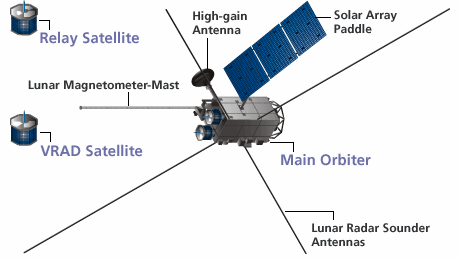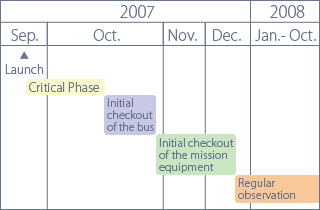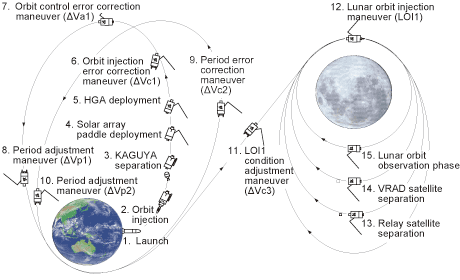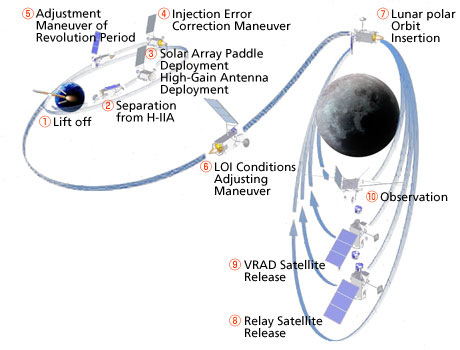
The "KAGUYA" consists of a Main Orbiter, which circulates 100 kilometers above the Moon, and two small satellites (a Relay Satellite and a VRAD Satellite).

KAGUYA Mission Profile [1:17]
Movie introducing KAGUYA's trip to the Moon with voice and subtitled explanation.Schedule of the KAGUYA
JAXA is pleased to announce that the operation mode of the lunar explorer, KAGUYA (SELENE), was shifted to regular operations from its initial verification on December 21, 2007 (Japan Standard Time) as we were able to acquire satisfactory verification results for all fifteen observation missions.
From now on, we will perform observation of the Moon's surface for about ten months to acquire data on "Moon Science" and other studies.


* The current schedule is based on a report to the Space Activities Commission on October 24, 2007.
Road to the Moon
Once the "KAGUYA" is launched, it will go around the Earth twice and then toward the Moon, before entering into a lunar orbit. The Main Orbiter of the "KAGUYA" will then separate the Relay Satellite and VRAD Satellite and observe the Moon's surface over a one-year period while it goes around the circular orbit 100 kilometers above the Moon passing over both poles. Each of the small satellites will circulate on different elliptic orbits to observe the Moon.
The KAGUYA will help us move closer to solving the mysteries of the Moon. What will it discover?
The KAGUYA will carry out more precise research on the Moon than any other previous exploration mission.
1. Science of the Moon
There is always volcanic activity on earth and mantle convection takes place under the ground, so the earth is constantly changing. Thus we can not understand the original figure of the earth. If we understand details of the Moon through observations by the KAGUYA (SELENE), we can resolve the mystery about when and how the Moon was formed.
2. Science on the Moon
There is an atmosphere around the earth, but not around the Moon. Thus sunlight directly hits the surface of the Moon. The "KAGUYA" will circulate around the Moon for about a year and conduct research on what influences the Sun is having on the Moon.
3. Science from the Moon
The KAGUYA is also equipped with devices that observe things other than the Moon. The space environment is suitable to observe electromagnetic waves in space, because no artificial electromagnetic waves such as from TV and cell phones exist there. In addition, the KAGUYA will be able to study the impact of the Sun on the Earth by observing both auroras of the North and South Poles at the same time from the Moon.